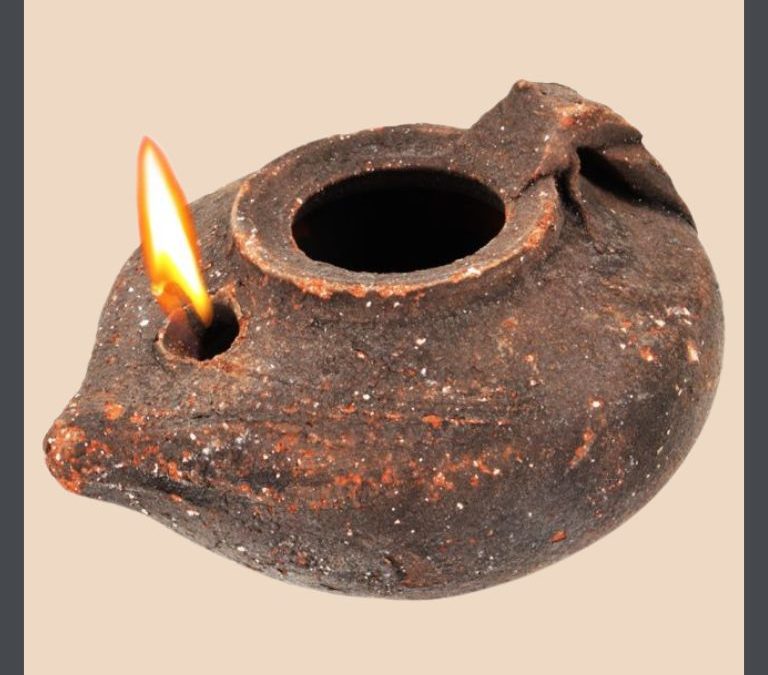
by bungalow101 | Aug 18, 2023 | The arts & the crafts, The History
OUT OF THE DARKNESS
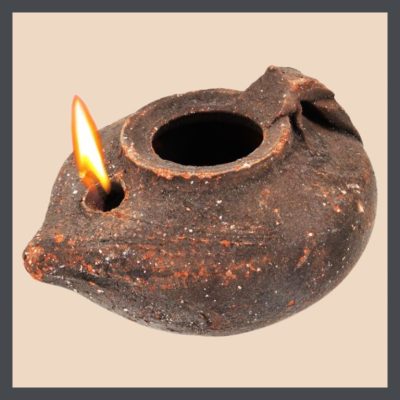 The desire for lighting is in our DNA. Our circadian rhythms, our bodies’ clocks, determine the patterns of our bodies, our minds & behavior over a 24 hour cycle & respond to light & dark. Light exposure generates signals from our brains, releasing hormones that keep us awake & perky during the day. Darkness activates sleep hormones.
The desire for lighting is in our DNA. Our circadian rhythms, our bodies’ clocks, determine the patterns of our bodies, our minds & behavior over a 24 hour cycle & respond to light & dark. Light exposure generates signals from our brains, releasing hormones that keep us awake & perky during the day. Darkness activates sleep hormones.
Early man slept when it was dark & trotted about hunting & gathering when it was light. But, as civilization developed, his activities expanded & he wanted to be active after the sun went down. He wanted to be able to see inside his cave.
Almost 130,000 years ago he learned to control fire, which was also handy for warmth & for cooking. It took another 100,000 years for him to make the first lamps, which employed animal fat as fuel. It wasn’t until 4500 B.C. that he invented the oil lamp which uses liquid oil, contained in a vessel, with a textile wick that is dropped in it. The top of the wick is ignited, producing a flame as the oil is drawn up the floating wick.
Following that leap in technology, lamp evolution pretty much stagnated for thousands of years. The American colonists used lamps that weren’t that much different from those used in biblical times- smokey, faint lighting, giving off little more light than candles.
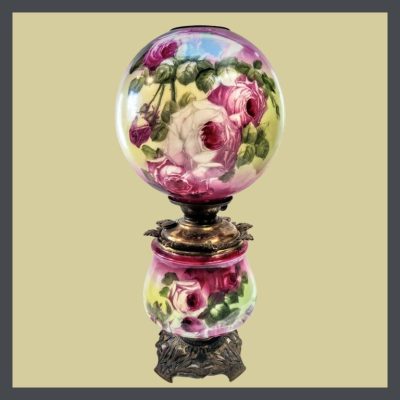 The kerosene lamp was developed in 1850 & was used until electricity took its place. This type of lamp is still sometimes used in emergencies when electricity fails & light is needed.
The kerosene lamp was developed in 1850 & was used until electricity took its place. This type of lamp is still sometimes used in emergencies when electricity fails & light is needed.
Of course when the Victorians came along, a lamp became a flower garden, though it was still the basic mechanism of wick & oil. By this time we had learned to mold glass & metal so every material was employed in a manner that obscured its basic nature & turned it into something else, to be displayed in a house of like objects, all competing for the title of the most ornate.
I am not going to say that I do not consider this lamp to be lovely. I’m always happy to see a rose, growing in a garden, or painted on a lamp, but, you have to agree that the materials, function & construction of this lamp are not immediately apparent, being buried under excessive ornamentation!
In 1879 Thomas Edison & Joseph Swan patented the carbon-thread incandescent (An incandescent light bulb, incandescent lamp or incandescent light globe is an electric light with a wire filament that is heated until it glows.) lamp & over the next couple decades electricity technology evolved rapidly & took the lead in powering America.
THE LIGHTING OF THE ARTS & CRAFTS MOVEMENT
I think that my favorite William Morris quote is, “We shall not be happy unless we live like good animals, unless we enjoy the exercise of the ordinary functions of life: eating, sleeping, loving, walking, running, swimming, riding, sailing.”
Somehow he strips away all gee-gaws from life which is the basis of the Arts & Crafts Movement. I am amused by fact that the prehistoric, earthen lamp above, so resembles the lamps of the Movement. Personally, I find its humble simplicity beautiful.
I think the best way to talk about the lighting is to talk about the craftspeople of the Movement’s early years. But first, let’s talk about harmony.
HARMONY OF LIGHTING DESIGN
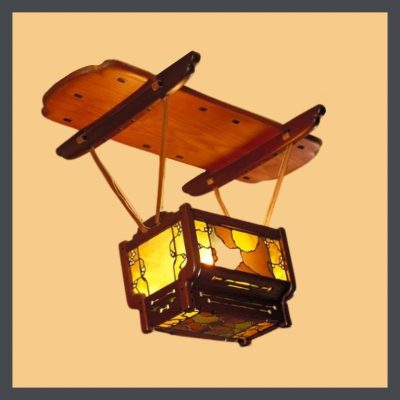 There’s nothing more beautiful than the fixtures you see in the Gamble House, or the amazing lamps of Stickley & other masters you see in the Museum of the American Arts and Crafts Movement in St. Pete, Florida.
There’s nothing more beautiful than the fixtures you see in the Gamble House, or the amazing lamps of Stickley & other masters you see in the Museum of the American Arts and Crafts Movement in St. Pete, Florida.
Harmony is the visually satisfying effect of combining similar or related elements. In the decorative arts, this means that the lighting that you see in the Gamble House or other ultimate bungalow, in a museum might not be appropriate in your modest home.
Often, the key visual, size is the first aspect to consider. The Gamble House is a whopping 8,100 square feet. The rooms are proportionately sized & the lighting’s dimensions fit the room. While a modest house may have beautiful built-ins of unpainted woodwork, the Gamble House boasts cuts of wood, hand-picked by Charles Greene out of Burma teak, Douglas fir beams, white oak & Port Orford cedar, cut in elaborate designs. The beautiful stained glass of the lightening is duplicated throughout the house & most impressively, in the massive entry.
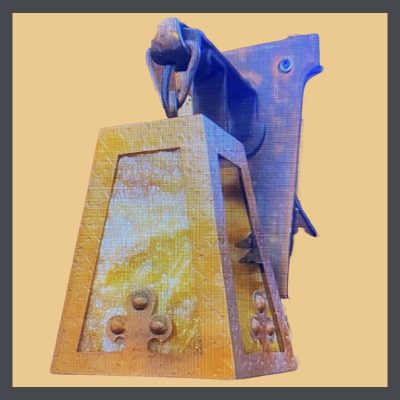 This is not meant in any way to denigrate your home. It is merely to state that the look & feel of your house are different from these bunga-mansions (as Jane Powell termed her magnificent house in Oakland) as their decorative elements look no more appropriate in a more simple home than would the crown jewels with your jeans. (And yes, I know that there are those out there who would wear such a combination & 1 in 1,000 of them would pull it off.) There are still some amazing options out there that would enhance your home rather than overwhelming it.
This is not meant in any way to denigrate your home. It is merely to state that the look & feel of your house are different from these bunga-mansions (as Jane Powell termed her magnificent house in Oakland) as their decorative elements look no more appropriate in a more simple home than would the crown jewels with your jeans. (And yes, I know that there are those out there who would wear such a combination & 1 in 1,000 of them would pull it off.) There are still some amazing options out there that would enhance your home rather than overwhelming it.
This little gem from Doc’s Architectural Salvation in Springfield, Tennessee. Complete with beautifully patterned slag glass, it is undisputedly Arts & Crafts & would harmonize with any architecture or decor in a bungalow.
In the same way, the light in your kitchen is not from a Frank Lloyd Wright designed house. A simple schoolhouse light is more appropriate & will set off the other design elements of your kitchen rather than overtaking them.
I’m a big believer in visual flow. Keeping within the period & style of your house will ensure that there won’t be so many focal points that your overall look will be difficult to determine. Ideally each item in the room will complement or complete the others & the focal points will be supported by all the other elements.
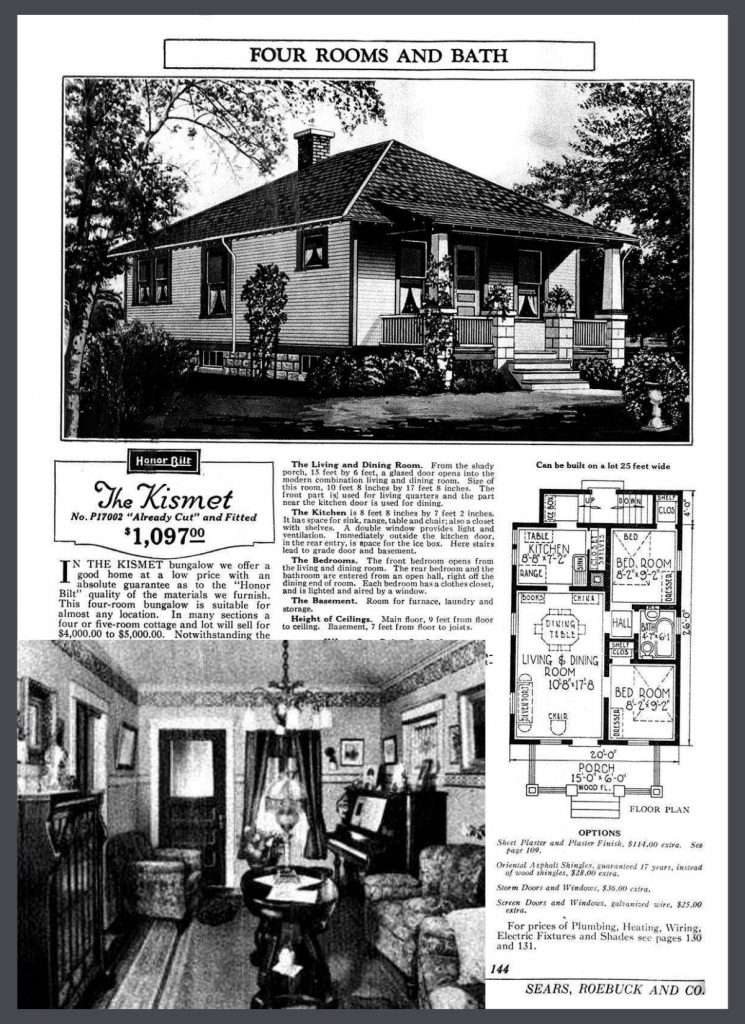
THIS IS JUST THE FIRST PART OF AN IN-DEPTH SERIES ON LIGHTING
Read them all!
 Part 2, THE CRAFTSMAN MAGAZINE LIGHTING ARTICLE
Part 2, THE CRAFTSMAN MAGAZINE LIGHTING ARTICLE
Tips on utilizing this new technology in the home.
 Part 3, THE LIGHTING OF THE A & C ERA
Part 3, THE LIGHTING OF THE A & C ERA
How lighting expresses the philosophy & aesthetic of the Movement.
 Part 4, ARTS & CRAFTS LIGHTING DESIGNERS
Part 4, ARTS & CRAFTS LIGHTING DESIGNERS
Taking a look at how this new technology provided a market & how the market was served.
 Part 5, WOMEN IN ARTS & CRAFTS LIGHTING
Part 5, WOMEN IN ARTS & CRAFTS LIGHTING
2 women who contributed to the Movement with their beautiful lamps.
 Part 6, ANTIQUE ARTS & CRAFTS LIGHTING RESOURCES
Part 6, ANTIQUE ARTS & CRAFTS LIGHTING RESOURCES
If you want something authentic, but not a museum piece.
 Part 7, MODERN DAY ARTS & CRAFTS LIGHTING MASTERS
Part 7, MODERN DAY ARTS & CRAFTS LIGHTING MASTERS
Craftsmen honoring the tradition.
 Part 8, REPRODUCTION ARTS & CRAFTS RESOURCES
Part 8, REPRODUCTION ARTS & CRAFTS RESOURCES
Another beautiful option.

STAY IN THE BUNGALOW KNOW!!!
Sign up for our newsletter & receive our FREE E-book, 7 VITAL Things to Do Before You Hire a Contractor.
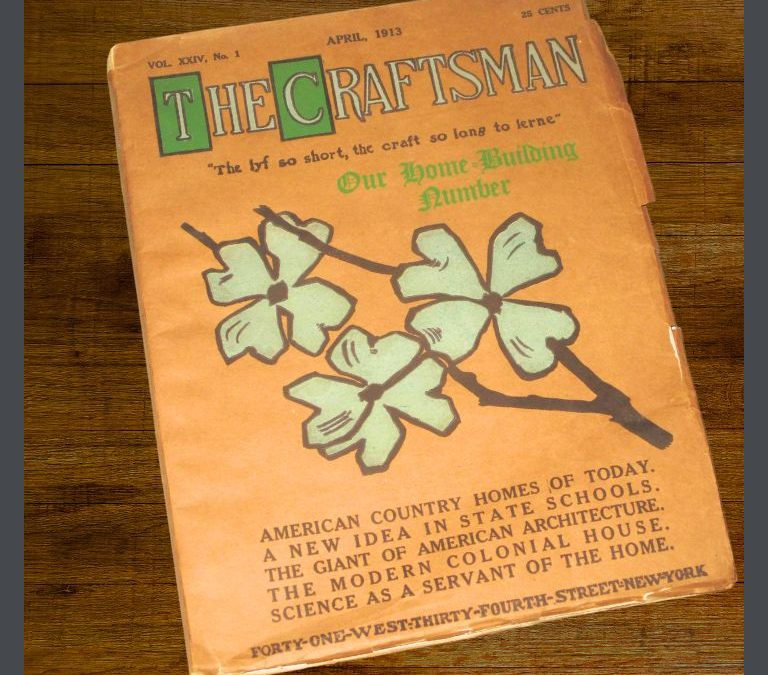
by bungalow101 | Aug 18, 2023 | The arts & the crafts
THE CRAFTSMAN MAGAZINE LIGHTING ARTICLE
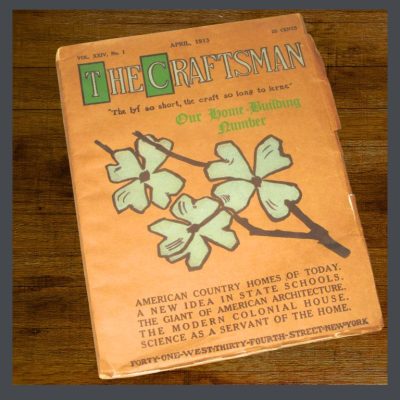 We move into a new house, even an old house that’s new to us, & the electrical is just there, be it knob & tube, or an updated system. It wasn’t always this way! Part 1 explains how we got from stumbling around in a dark cave, to our modern day use of electricity which is pretty casual.
We move into a new house, even an old house that’s new to us, & the electrical is just there, be it knob & tube, or an updated system. It wasn’t always this way! Part 1 explains how we got from stumbling around in a dark cave, to our modern day use of electricity which is pretty casual.
Although much of the information is this article is pretty much taken for granted, I appreciated the advice given about the use of light bulbs & shades.
LIGHTING THE HOME BY ELECTRICITY
THE CRAFTSMAN
an Illustrated Monthly Magazine in the Interest of Better Art, Better Work, and a Better and More Reasonable Way of Living.
April, 1913
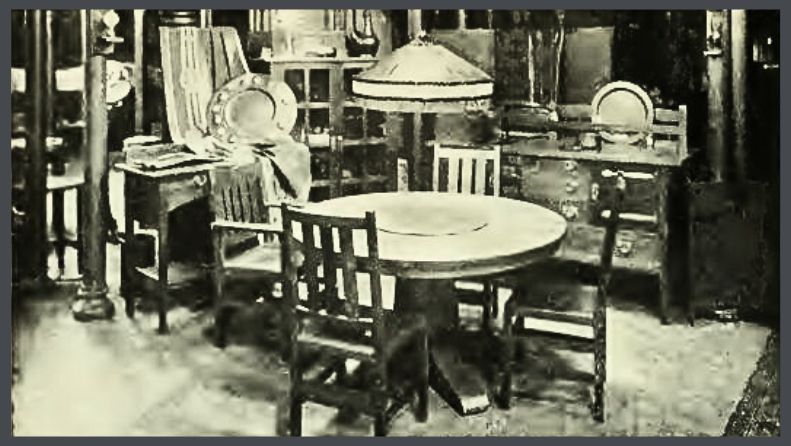
Electric dome light for dining room
Since evening is often the time when each member of the family is most at liberty to enjoy the home, it appears as a matter of reason that it should, wherever possible, be well and artistically lighted. In fact light stands for cheerfulness as well as brilliancy, for decoration as well as utility, for cosiness as well as sharp disclosures. Whatever else may be the qualities of the home furnishings, yet are they dependent upon whether a cursory or a careful study has been given to their illumination.
The true craftsman planning his residence will have taken the first great step when he has chosen a sensible location for the lighting outlets. Whether these outlets be for a ceiling light, a table lamp, or a wall bracket, they settle once and for all the place of the light source. Consequently they ought not to be passed over lightly, but should be discussed fully with the architect’s electrical expert or with a competent illuminating engineer. The location determines where the most light will ordinarily be and where the shadows will fall; it influences the choice of the fixture, the placing of furniture, and other perfectly tangible items that a glance into the near future will generally disclose.
THE ENTRY
On the lower floor the lighting of porch and doorway are of utmost importance. Outlets by each side of the doorway for wall lanterns are necessary to secure ornamentation, while beneath one such outlet may be provided a connection for an illuminated house number. If the porch be of considerable length it is well to provide two ceiling lights, symmetrically spaced, for general service. Often a low wall or floor receptacle is appreciated when a table lamp is used for outdoor reading in summertime.
THE LOWER FLOOR
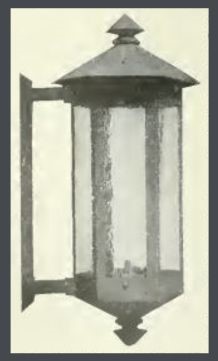
Simple type of electric bracket lantern
In the reception hall the lighting outlet—and one is sufficient—must appear symmetrical with regard to a front window, this being often the place where a light burns when all others are turned out. In case there are no other lights used, such as a newel lamp, an effort should be made to so place this ceiling outlet that ample illumination is furnished for the stairs ; furthermore, the light should be so directed that the shadow of one stair tread is not thrown on the one below.
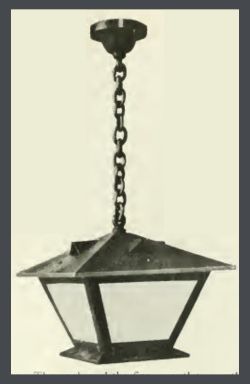
Novel design for electric lantern
On the beamed ceiling in the living room it is logical to have the outlets appear at the two places which are symmetrical with the nook, the window-seat, the dining-room doorway, and at centers of equal rectangles of ceiling surface, that general uniform lighting may be secured. Outlets for brackets on each side of the window-seat take care of decorative lights. Provision for electrical attachments in the center of the floor and low in the wainscoting at one side will always be serviceable for the family reading table and writing-desk lamps.
The nook and the fireplace should have two well placed bracket outlets that provide for reading, and two places for portable lamp attachments on a level with the mantel-shelf. A piano lamp may be connected at the nearest bracket or attached to a baseboard receptacle.
THE DINING ROOM
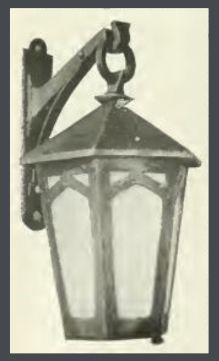
Electric bracket lantern
The dining room should have the central ceiling outlet for the table dome, the two brackets each side of the buffet, and the wainscoting receptacle. The latter, as a hint for economy in wiring cost, is sometimes located in the partition wall opposite a similar outlet in the living room. A floor outlet beneath the central dining table will be convenient for electric table candies.
PANTRIES, CLOSETS & KITCHEN
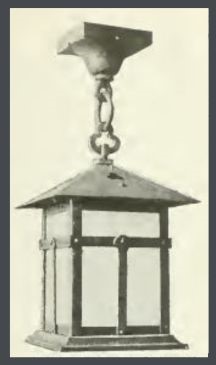
Square electric lantern
Pantries and closets are well-lighted from a central ceiling lamp, the kitchen likewise, due care being taken to have considerable light fall over the left shoulder of the person standing before the stove.
A bracket light over the left end of the sink board will facilitate operations there.
Usually a single ceiling light on the rear porch high enough to light the treads of the porch steps will suffice.
THE SECOND FLOOR
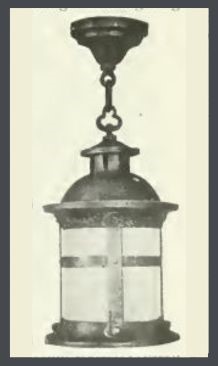
Round electric lantern
The placing of the lighting outlets on the second floor does not involve as much thought, since the desire is usually for some simple type of central ceiling fixture to light the bedrooms uniformly, assisted by local lamps, one on each side of a dresser or mirror.
By all means the best bath room equipment must include an outlet for brackets each side of a shaving mirror, since one on the left is insufficient.
Much of the ultimate success of home lighting depends on the common sense control or switching devices that are used. Wall switches are a necessity for all ceiling lights. The so-called “three-point” or “fourpoint” switches are indispensable in enabling the lower hall lights to be turned on or off from either upper or lower halls; and the upper hall light to be similarly controlled from above or below.
Small button switches can be placed in the base or canopies of wall brackets, while door switches that operate automatically with the opening and closing of closet doors are great savers of current and will pay for themselves many times over. Another economical device often found in well appointed houses consists of tell-tale or “pilot” lamps—small colored lights placed in easy view in some much occupied room, and which are arranged to burn whenever lights in basement or attic are burning. Lights in such places often burn forgotten for days at a time before discovery, and to such waste the pilot lamps call attention.
Finally, a master switch to control all the lights of the home at once and from a given place will prove the best burglar scaring device possible.
LIGHT BULBS & SHADES
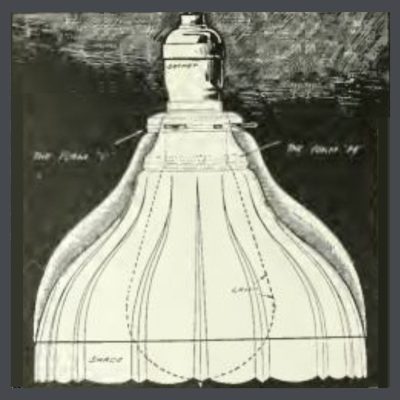
Detail showing two common forms of shade holders
Bare lamp bulbs must never be exposed to view unless they are frosted. The most flagrant violations of this rule occur when the glass shade is too small, or too flat, or when the wrong shade holder is used. For all ordinary electric shades there are but two types of holders, designated as forms “O” and “H.” These are readily distinguishable since the first one mentioned is shallow, and the latter is about one inch deeper.
The sketch shows these two types in their essential features, and shows furthermore how the same shade may be held in its correct place down around the lamp or too high up on it.
Sometimes the shade holders are in the form of a casing or “husk,” completely enclosing the socket, in which event the husk must be originally made of the correct length for the exact shade and lamp combination that is to be used. Common holders, such as shown in the sketch, are readily detachable from the socket, so form “H'”may be substituted for form “O,” or vice versa.
A COMMON MISTAKE
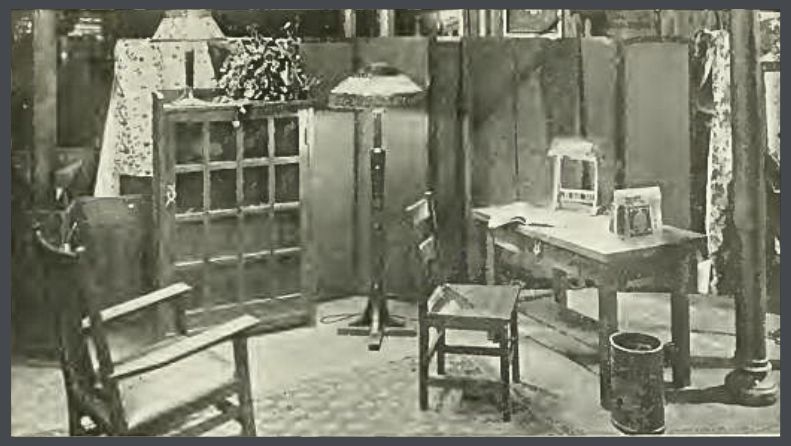
Craftsman standard lamp with woven willow shade
These facts are primary and essential. The householder can allow his lighting installation to be marred more often by using one form of holder where the other type should be used than by any other mistake- a result the most glaring fault is the one in which the lamp bulb projects below the lower rim of the shade, causing a large loss of lighting efficiency and a harmful, glaring light from exposed lamp filaments.
Even bulbs in correct positions in shades should be frosted on their lower end, or “bowl frosted,” except perhaps in certain very deep and narrow types of shades.
A residence shade should protect the eves; redirect the light rays of highly decorative accessories, limiting them to certain areas, and also heighten aesthetic effects through the charm of warm and cool colors. These are procurable in a great many designs of shades that are of so-called milkglass, which diffuses and reflects the rays and which, when substituted for the cheaper crystal roughed shades, soon pays for itself.
Colored shades are of many kinds. Some are good reflectors, or comparatively small absorbers of light, and these of course will be chosen first. They have decidedly different appearances and tints when lighted than when “cold,” a fact which should not be overlooked in purchasing.
SIZES AND TYPES OF BULBS
The lamp bulbs themselves, if we grant electricity to be the source of light, must be of the sizes recommended by the shade manufacturers or equally competent authorities. Undoubtedly the greatest saving of expense comes from the use of the tungsten or metal filament lamps. Variations of one of the three general classes of lighting fixtures, namely, the direct, the indirect, or the semi-indirect, would
be suitable for many rooms in the home.
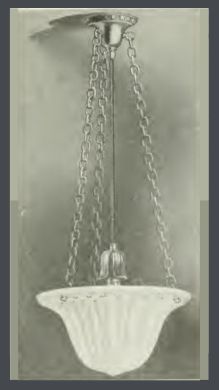
Lighting fixture of the indirect type
Briefly, these types are interdistinguishable in that the direct lighting system employs one-arm or several-arm fixtures with downward pointing open bottom shades; the indirect uses inverted opaque reflectors that throw all of their rays upward to the ceiling surface, from whence the light is broadly diffused; and the semi-indirect system uses inverted shades or bowls of translucent glass or cloth, giving some directly downward diffused light and some light that is broadly spread about, after having been thrown to the ceiling.
The accompanying illustration of the semi-indirect glass bowl and three-chain support is a typical one of this last and deservedly popular type. Such a semi-indirect fixture would be excellent in a hallway of ordinary dimensions, if we, in placing it, take due care that it will not shine directly into the eyes of a person descending the stairs. Similar types of bowls are well chosen for the library of many homes, as one of the illustrations here discloses, for such fixtures prevent glare and form soft and cheerful units. Portable lamps in conjunction with such ceiling fixtures fit in admirably and are in themselves, worthy of much attention.
The end-
Take a look at my Pinterest page to view more examples of Stickley lighting & furniture. If you should like to learn more about Stickley, you can watch some great videos here.
THIS IS JUST PART 2 OF AN IN-DEPTH SERIES ON LIGHTING
Read them all!
 Part 1, OUT OF THE DARKNESS
Part 1, OUT OF THE DARKNESS
The harnessing of light.
 Part 3, THE LIGHTING OF THE A & C ERA
Part 3, THE LIGHTING OF THE A & C ERA
How lighting expresses the philosophy & aesthetic of the Movement.
 Part 4, ARTS & CRAFTS LIGHTING DESIGNERS
Part 4, ARTS & CRAFTS LIGHTING DESIGNERS
Taking a look at how this new technology provided a market & how the market was served.
 Part 5, WOMEN IN ARTS & CRAFTS LIGHTING
Part 5, WOMEN IN ARTS & CRAFTS LIGHTING
2 women who contributed to the Movement with their beautiful lamps.
 Part 6, ANTIQUE ARTS & CRAFTS LIGHTING RESOURCES
Part 6, ANTIQUE ARTS & CRAFTS LIGHTING RESOURCES
If you want something authentic, but not a museum piece.
 Part 7, MODERN DAY ARTS & CRAFTS LIGHTING MASTERS
Part 7, MODERN DAY ARTS & CRAFTS LIGHTING MASTERS
Craftsmen honoring the tradition.
 Part 8, REPRODUCTION ARTS & CRAFTS RESOURCES
Part 8, REPRODUCTION ARTS & CRAFTS RESOURCES
Another beautiful option.

STAY IN THE BUNGALOW KNOW!!!
Sign up for our newsletter & receive our FREE E-book, 7 VITAL Things to Do Before You Hire a Contractor.

by bungalow101 | Aug 17, 2023 | The arts & the crafts
THE LIGHTING OF THE A&C ERA
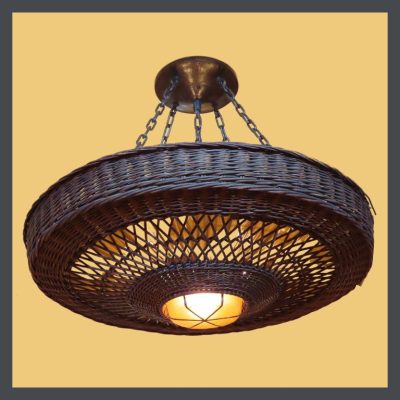 The lighting of the A&C era parallels the philosophy & aesthetic of period. Pieces were uncomplicated, inspired by nature & complemented the look of the architecture, the furniture & the other items in the room. Materials were employed “honestly,” which is to say, they were not meant to have the appearance of something that they were simply not. Metal was not molded & gilded to resemble a bouquet of flowers. It was hammered & patinated to enhance its natural qualities. Lamps were made of clay from the earth, or even willow branches. Those created by Californian Elizabeth Eaton Burton, were made in the sinuous shapes of the ocean & she even embellished them with seashells!
The lighting of the A&C era parallels the philosophy & aesthetic of period. Pieces were uncomplicated, inspired by nature & complemented the look of the architecture, the furniture & the other items in the room. Materials were employed “honestly,” which is to say, they were not meant to have the appearance of something that they were simply not. Metal was not molded & gilded to resemble a bouquet of flowers. It was hammered & patinated to enhance its natural qualities. Lamps were made of clay from the earth, or even willow branches. Those created by Californian Elizabeth Eaton Burton, were made in the sinuous shapes of the ocean & she even embellished them with seashells!
Simple round or square shapes were used to house the bulbs. This is not to say that the striving to create a beautiful object was abandoned. It was a different beauty, widely divergent from the ornate excess of the Victorians with their miles of scroll work & armies of plump cherubs. I urge you to learn more about the Arts & Crafts aesthetic in DESIGNING YOUR BUNGALOW’S INTERIOR SPACES– an Introduction.
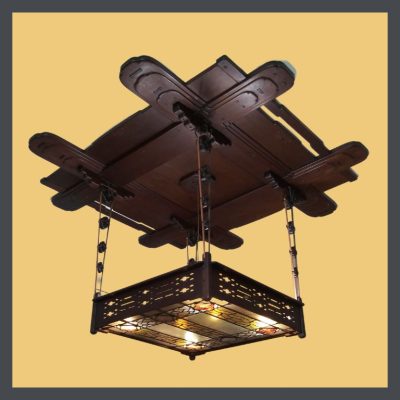 Like our homes with their myriad influences, both high style & vernacular, from the rustic hut of India to the Swiss Chalet to the flair of Japan, the lighting of the A&C era displays a charming range of styles, many of which are appropriate in our bungalows. Some styles are easy to combine, & others are not so easy to integrate. For example, a more modest Stickley lamp, created for the middle-class home, would feel like a poor relation in a Greene & Greene bungamasion. A ceiling fixture like this exquisite example of lighting from the Robert Blacker House, would not be in harmony with the other elements of our living rooms.
Like our homes with their myriad influences, both high style & vernacular, from the rustic hut of India to the Swiss Chalet to the flair of Japan, the lighting of the A&C era displays a charming range of styles, many of which are appropriate in our bungalows. Some styles are easy to combine, & others are not so easy to integrate. For example, a more modest Stickley lamp, created for the middle-class home, would feel like a poor relation in a Greene & Greene bungamasion. A ceiling fixture like this exquisite example of lighting from the Robert Blacker House, would not be in harmony with the other elements of our living rooms.
STYLES IN THE LIGHTING OF THE A&C ERA
Generally, in a single room the same style, which complements the architecture, the furniture & other décor, would be repeated in the attached fixtures & also in the table & floor lamps. The private spaces held lighting that was more modest. Life was more formal when our homes were built & guests did not casually venture into these areas. I read somewhere (I read a lot about old houses!) that marble thresholds which poked out from the doorways, were used in bathrooms to indicate where the facilities were located so that guests would not embarrass themselves by inadvertently entering m’lady’s boudoir when wandering through a closed door in the hallway in search of the commode. Truth or urban legend? I don’t know, but it sounds plausible!
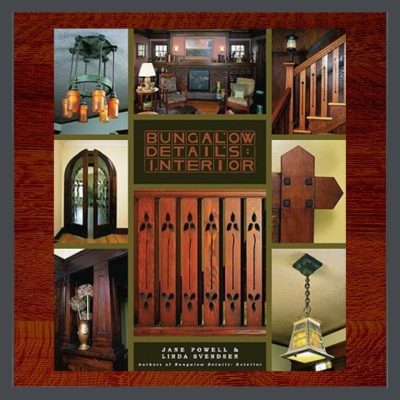 Jane Powell’s book, BUNGALOW DETAILS: INTERIOR includes some beautiful images of lighting in the section, Entry Level. In it she states. “The earliest electric lights tended to be nothing more than a bare light bulb on a cord- a conspicuous display of new technology-but these soon morphed into simple pendants, sconces, chandeliers & so forth. Arts & Crafts design influence on fixtures was wide-ranging.”
Jane Powell’s book, BUNGALOW DETAILS: INTERIOR includes some beautiful images of lighting in the section, Entry Level. In it she states. “The earliest electric lights tended to be nothing more than a bare light bulb on a cord- a conspicuous display of new technology-but these soon morphed into simple pendants, sconces, chandeliers & so forth. Arts & Crafts design influence on fixtures was wide-ranging.”
It is worthwhile to read this information which also tells you a great deal about the development of the lightbulb.
We need to consider historic lighting of the A&C era in a er-r-r, different light, from today’s illumination sources. Before the turn of the last century, we had been accustomed to living in the dim light of gas or candles. With the advent of home electricity, we gained considerable wattage, but though it was still below that provided by today’s LED’s, it was glaring to those unaccustomed to its intense glow. I have included in this series, an article straight out of Stickley’s Craftsman magazine, LIGHTING THE HOME BY ELECTRICITY which addresses this issue & I will be covering the subject of choosing the best modern technology lightbulbs in a future article.
TIP: For a major treat, visit, the Pinterest page of AntiqueLighting.com.
THIS IS ONLY ONE PART OF A SERIES ON ARTS & CRAFTS LIGHTING
Be sure to read it all!
 Part 1, OUT OF THE DARKNESS
Part 1, OUT OF THE DARKNESS
The harnessing of light.
 Part 2, THE CRAFTSMAN MAGAZINE LIGHTING ARTICLE
Part 2, THE CRAFTSMAN MAGAZINE LIGHTING ARTICLE
Tips on utilizing this new technology in the home.
 Part 4, ARTS & CRAFTS LIGHTING DESIGNERS
Part 4, ARTS & CRAFTS LIGHTING DESIGNERS
Taking a look at how this new technology provided a market & how the market was served.
 Part 5, THE WOMEN OF ARTS & CRAFTS LIGHTING
Part 5, THE WOMEN OF ARTS & CRAFTS LIGHTING
Two women whose beautiful work left their mark on the Movement.
 Part 6, ANTIQUE ARTS & CRAFTS LIGHTING RESOURCES
Part 6, ANTIQUE ARTS & CRAFTS LIGHTING RESOURCES
If you want something authentic, but not a museum piece.
 Part 7, MODERN DAY ARTS & CRAFTS LIGHTING MASTERS
Part 7, MODERN DAY ARTS & CRAFTS LIGHTING MASTERS
Craftsmen honoring the tradition.
 Part 8, REPRODUCTION ARTS & CRAFTS RESOURCES
Part 8, REPRODUCTION ARTS & CRAFTS RESOURCES
Another beautiful option.

STAY IN THE BUNGALOW KNOW!!!
Sign up for our newsletter & receive our FREE E-book, 7 VITAL Things to Do Before You Hire a Contractor.
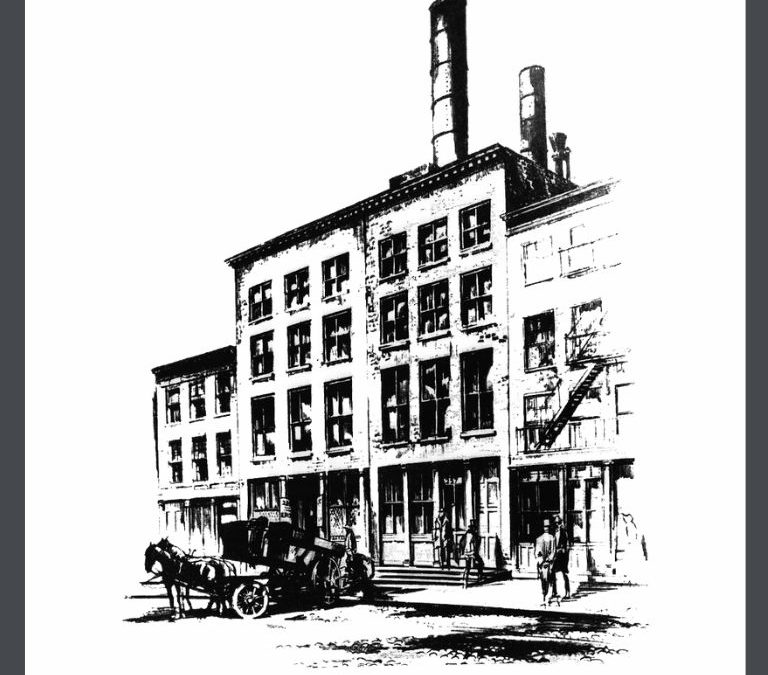
by bungalow101 | Aug 16, 2023 | The arts & the crafts
ARTS & CRAFTS LIGHTING DESIGNERS- Van Erp & Stickley
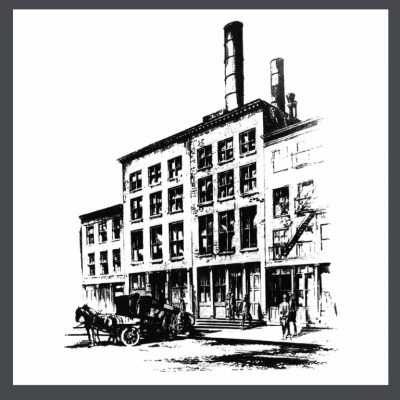 In 1882, the first houses in America got electricity by direct current after Thomas A Edison opened the Pearl Street Power Station in New York City. Consuming coal for fuel, Pearl Street Station, began by serving 400 lamps at 82 houses. Only 2 years later, Pearl Street Station was serving 508 customers with 10,164 lamps! A wonderful opportunity for the Arts & Crafts lighting designers of the period.
In 1882, the first houses in America got electricity by direct current after Thomas A Edison opened the Pearl Street Power Station in New York City. Consuming coal for fuel, Pearl Street Station, began by serving 400 lamps at 82 houses. Only 2 years later, Pearl Street Station was serving 508 customers with 10,164 lamps! A wonderful opportunity for the Arts & Crafts lighting designers of the period.
Metropolitan areas got electric power long before rural ones, again a matter of economics. It was costly to install the poles & string the wires that carried the power, so utility companies would send people out to areas that had no service yet to survey families as to how much current they were likely to use each month & ask if they were interested in having service to their homes. As you might imagine, it was pretty easy to sign people up.
In the early 1900’s, an area was built of used of “demonstration homes” for Seattle City Light. The houses in that old subdivision were built wired for electricity (60 amp service) but also still had gas lighting in the public rooms because gas light was preferred by some people. The deed included a clause stating, “light bulbs as long as you own the house”.
Yes, electric lamps were in demand & designers hopped right on it! Craftsman Workshops, Stickley Brothers, & Roycroft, all displayed their lighting fixtures in model rooms, designed to complement their furniture, metalwork, & textiles.
One of the most fabulous areas of the American Museum of Arts & Crafts is the lighting exhibit. Below are some of the masters whose work is displayed there.
DIRK VAN ERP- METALSMITH
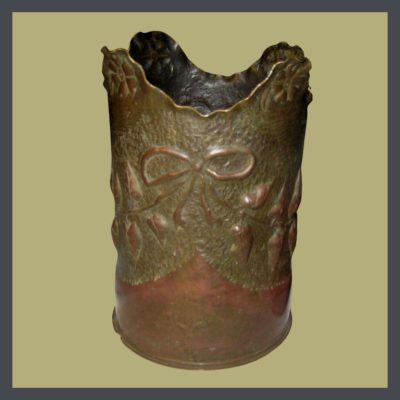 I consider Van Erp’s simple lighting, constructed of hand-hammered copper with mica shades, to be iconic symbols of the Arts & Crafts Movement. He is considered to be the most important metalsmith of the Movement & one of the foremost Arts & Crafts lighting designers.
I consider Van Erp’s simple lighting, constructed of hand-hammered copper with mica shades, to be iconic symbols of the Arts & Crafts Movement. He is considered to be the most important metalsmith of the Movement & one of the foremost Arts & Crafts lighting designers.
Van Erp was born into a family of coppersmiths in 1862, in the Netherlands. Coming to America in 1890, he worked at Union Iron Works until 1900, when he moved to Vallejo, California & began working at the Mare Island Naval Shipyard & he began hammering vases from brass shell casings which he gave to friends. His earlier pieces are in the more ornate Victorian style but as time progresses, you can see the A&C influence, featuring objects of a hand-hammered simplicity, to satisfy marketplace demand.
About 1907 Van Erp began selling to art galleries & a year later, he founded the Art Copper Shop in Oakland. Exhibiting his work at local Arts & Crafts exhibitions, a year later, his shop won a gold medal at the World’s Fair held in Seattle, Washington.
That same year, he began a short-lived partnership with Elizabeth Eleanor D’Arcy Gaw who had attended The Art Institute of Chicago as well as having studied English Arts & Crafts in London. He was influenced by her designs & began incorporating mica into the shades. This material would become a part of his trademark.
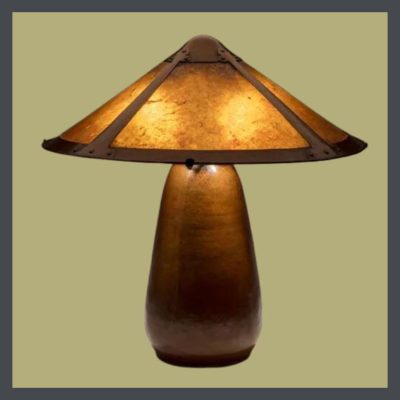 In addition to his rustic hammering, Van Erp was admired for the beautiful patinas of his pieces. These were created by the use of assorted chemicals & processes depending on the color desired- primarily red, but yellow & dark browns often added interest & depth to the red. Van Erp did not teach the methods or the formulations of these applied patinas to his apprentices, nor even to own his children! Over the decades, people have experimented with many materials- chalk, brick dust, various chemicals trying to duplicate his colors. No one has achieved a dependable formula.
In addition to his rustic hammering, Van Erp was admired for the beautiful patinas of his pieces. These were created by the use of assorted chemicals & processes depending on the color desired- primarily red, but yellow & dark browns often added interest & depth to the red. Van Erp did not teach the methods or the formulations of these applied patinas to his apprentices, nor even to own his children! Over the decades, people have experimented with many materials- chalk, brick dust, various chemicals trying to duplicate his colors. No one has achieved a dependable formula.
Today his work is widely emulated by skilled artisans as well as manufacturers of mass-produced goods. Most of his original work is signed with his windmill signature, in several variations. To see more examples of his work, check out my Pinterest page.
FYI- In 2002, a Van Erp lamp sold for $180,000 at a Rago auction.
GUSTAV STICKLEY- DESIGNER, PHILOSOPHER, ENTREPENEUR
Stickley is the patriarch of Arts & Crafts in America having brought the philosophy & design with him from Europe. He is seen in interesting contrast to van Erp who was first a metalsmith, rather than an idealist, but both were entrepreneurs & skilled at marketing their wares.
LIGHTING THE HOME BY ELECTRICITY
From The craftsman Vol. XXIV, Number 1 April 1913
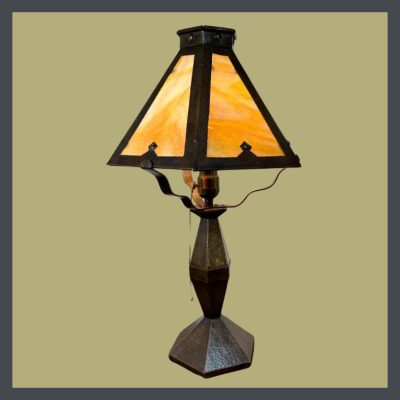 “Since evening is often the time when each member of the family is most at liberty to enjoy the home, it appears as a matter of reason that it should, wherever possible, be well and artistically lighted. In fact light stands for cheerfulness as well as brilliancy, for decoration as well as utility, for cosiness as well as sharp disclosures. Whatever else may be the qualities of the home furnishings, yet are they dependent upon whether a cursory or a careful study has been given to their illumination.”
“Since evening is often the time when each member of the family is most at liberty to enjoy the home, it appears as a matter of reason that it should, wherever possible, be well and artistically lighted. In fact light stands for cheerfulness as well as brilliancy, for decoration as well as utility, for cosiness as well as sharp disclosures. Whatever else may be the qualities of the home furnishings, yet are they dependent upon whether a cursory or a careful study has been given to their illumination.”
To read the entire article, click here.
The text goes on to discuss what “careful study” would be & begins with the proper placement of lights & other objects in each room, from the front porch to the living room to the bathroom (on each side of the shaving mirror), taking into account where one would want the sharpest light to focus & where the shadows would fall. He also advises the reader to consider wiring costs & safety. And as mentioned, there is the choice of fixtures as ornamentation.
The article addresses all types of fixtures- pendants, chandeliers, sconces & table & floor lamps. He suggests that rooms have several sources of lighting in order to diffuse & soften the central source of illumination, a technique still used by decorators today.
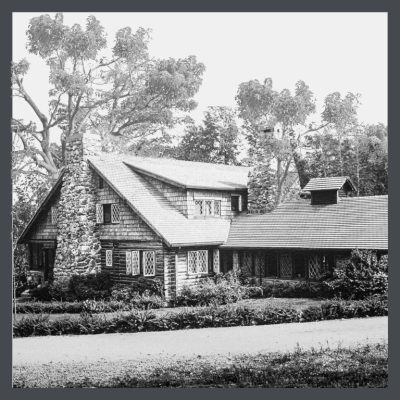 An entrepreneur is defined as a person who organizes and operates a business or businesses, taking on greater than normal financial risks in order to do so. Stickley definitely took enormous risks as he strove to be the arbiter of taste for his period. Like Martha Stewart, in his publication, The Craftsman Magazine, there are articles about landscaping, furnishings architecture, good design, even encouraging home crafting by printing plans for making furniture in the Craftsman style. He built a bit of an empire- a large department store in which he sold furniture, lighting, textiles, in the style he termed Craftsman. His home, in which he had planned to start a school, became a farm where he grew the food for the beautiful restaurant in his store. A good way to understand him & his contributions is to watch these videos about him.
An entrepreneur is defined as a person who organizes and operates a business or businesses, taking on greater than normal financial risks in order to do so. Stickley definitely took enormous risks as he strove to be the arbiter of taste for his period. Like Martha Stewart, in his publication, The Craftsman Magazine, there are articles about landscaping, furnishings architecture, good design, even encouraging home crafting by printing plans for making furniture in the Craftsman style. He built a bit of an empire- a large department store in which he sold furniture, lighting, textiles, in the style he termed Craftsman. His home, in which he had planned to start a school, became a farm where he grew the food for the beautiful restaurant in his store. A good way to understand him & his contributions is to watch these videos about him.
I’m guessing that Stickley lighting is the most often reproduced & though much of it is represented as being in the Stickley style, there are possibly some pretty good forgeries floating around out there. The Stickley furniture company has a lovely line of lamps but if you want to really be impressed by the lighting of Stickley & others, you need to visit the American Arts & Crafts Museum in St. Petersburg, Florida.
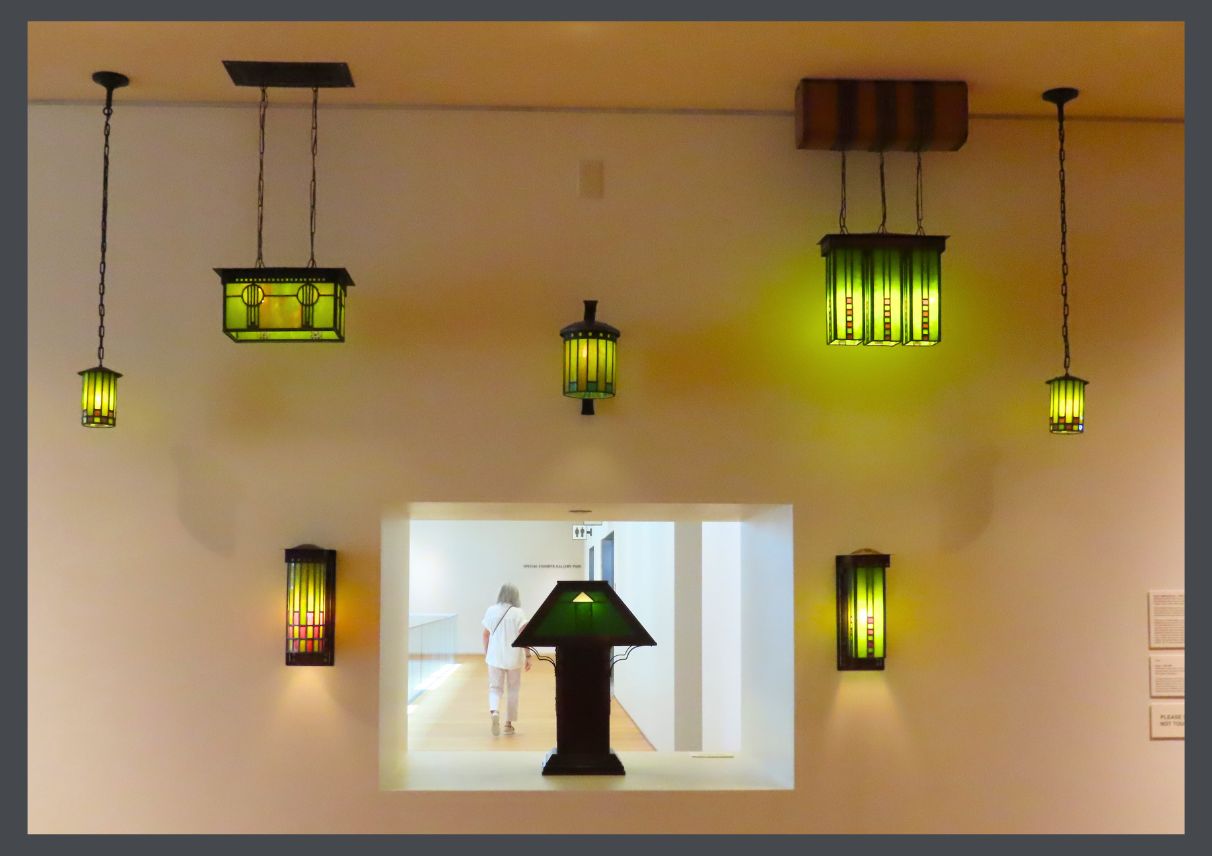
Meanwhile, take a look at my Pinterest page to view more examples of his work.
ONLY 1 PART OF A FULL SERIES ON ARTS & CRAFTS LIGHTING
Read them all!!!
 Part 1, OUT OF THE DARKNESS
Part 1, OUT OF THE DARKNESS
The harnessing of light.
 Part 2, THE CRAFTSMAN MAGAZINE LIGHTING ARTICLE
Part 2, THE CRAFTSMAN MAGAZINE LIGHTING ARTICLE
Tips on utilizing this new technology in the home.
 Part 3, THE LIGHTING OF THE A & C ERA
Part 3, THE LIGHTING OF THE A & C ERA
How lighting expresses the philosophy & aesthetic of the Movement.
 Part 5, THE WOMEN OF ARTS & CRAFTS LIGHTING
Part 5, THE WOMEN OF ARTS & CRAFTS LIGHTING
The women whose beautiful work left their mark on the Movement.
 Part 6, ANTIQUE ARTS & CRAFTS LIGHTING RESOURCES
Part 6, ANTIQUE ARTS & CRAFTS LIGHTING RESOURCES
If you want something authentic, but not a museum piece.
 Part 7, MODERN DAY ARTS & CRAFTS LIGHTING MASTERS
Part 7, MODERN DAY ARTS & CRAFTS LIGHTING MASTERS
Craftsmen honoring the tradition.
 Part 8, REPRODUCTION ARTS & CRAFTS RESOURCES
Part 8, REPRODUCTION ARTS & CRAFTS RESOURCES
Another beautiful option.

STAY IN THE BUNGALOW KNOW!!!
Sign up for our newsletter & receive our FREE E-book, 7 VITAL Things to Do Before You Hire a Contractor.
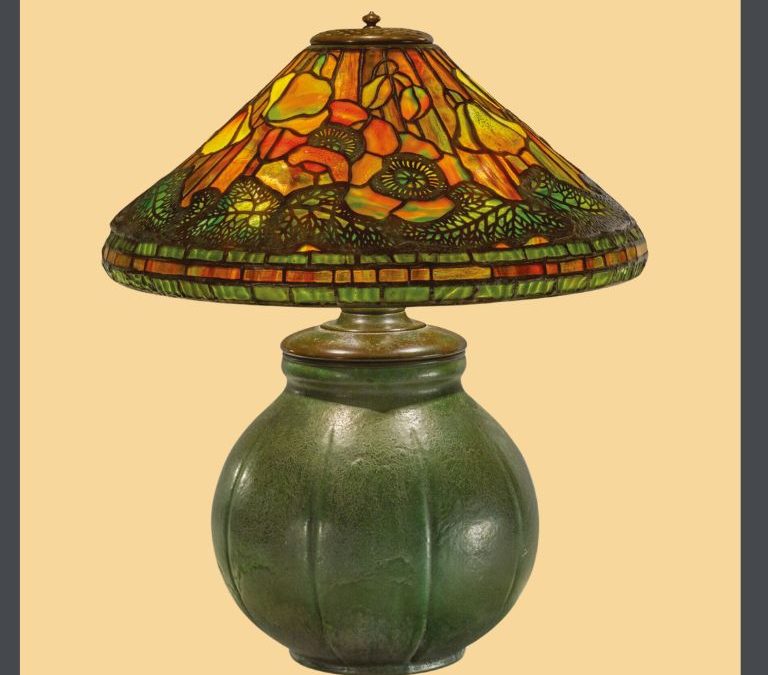
by bungalow101 | Aug 15, 2023 | The arts & the crafts
WOMEN IN ARTS & CRAFTS LIGHTING
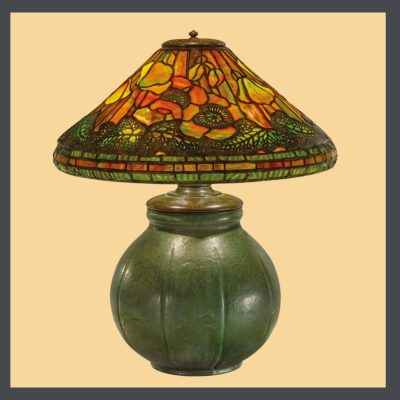 There were many women who were involved in the making of Arts & Crafts lighting. For example, at Grueby, a pottery manufacturer which often partnered with other designers such as Stickley & Tiffany to make lamps, male potters formed the clay & women painted it. Newcomb Pottery, which also made lamps, was founded in 1895 as an educational experiment of H. Sophie Newcomb Memorial College (Tulane University’s former women’s college) in New Orleans. The quasi-commercial program provided an opportunity for Southern women to support themselves financially during & after their training as artisans.
There were many women who were involved in the making of Arts & Crafts lighting. For example, at Grueby, a pottery manufacturer which often partnered with other designers such as Stickley & Tiffany to make lamps, male potters formed the clay & women painted it. Newcomb Pottery, which also made lamps, was founded in 1895 as an educational experiment of H. Sophie Newcomb Memorial College (Tulane University’s former women’s college) in New Orleans. The quasi-commercial program provided an opportunity for Southern women to support themselves financially during & after their training as artisans.
One hundred years later, the immense contributions of women at Tiffany are finally being recognized. The nearly unknown “Tiffany Girls” designed & created lamps & lampshades including many of Tiffany’s most beloved pieces. The base of this exquisite piece was created by Grueby & the shade by Tiffany.
There was a wonderful book, A New Light on Tiffany: Clara Driscoll and the Tiffany Girls written about these gifted women who worked behind the scenes at the Tiffany Studios.
In this article, I want to focus on two women of Arts & Crafts lighting, Lillian McNeill Palmer & Elizabeth Eaton Burton because I am very fond of their work. Both display a distinct femininity that is lacking in the work of their male counterparts.
LILLIAN McNEILL PALMER
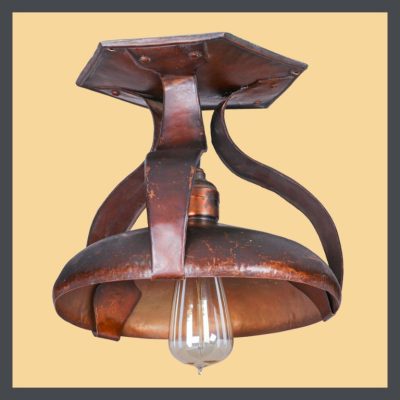 Palmer & Van Erp, both being metalsmiths, were rivals, with Palmer stealing artists from Van Erp, even his own nephew! (Perhaps this explains why Van Erp refused to teach anyone, even his family about how he created his finishes!)
Palmer & Van Erp, both being metalsmiths, were rivals, with Palmer stealing artists from Van Erp, even his own nephew! (Perhaps this explains why Van Erp refused to teach anyone, even his family about how he created his finishes!)
In the 1900s, Palmer worked as a writer & editor for the Mercury Publishing Company which seems to have focused on Theosophical matters, & started gaining an interest in Arts & Crafts metalwork, creating a metal working studio in her parents’ basement. From there she started her business of making & marketing light fixtures.
Both she & Van Erp (& many others) took advantage of the opportunities created by the 7.8 magnitude quake that struck San Francisco on April 18, 1906. For 3 days fired raged over the city, turning almost 300,000 structures to ash. The rebuilding that occurred afterward provided an economic boon to those involved in construction & to those providing decorative embellishments for the home, including Palmer who was among the first recorded metal artists using copper, lead & brass.
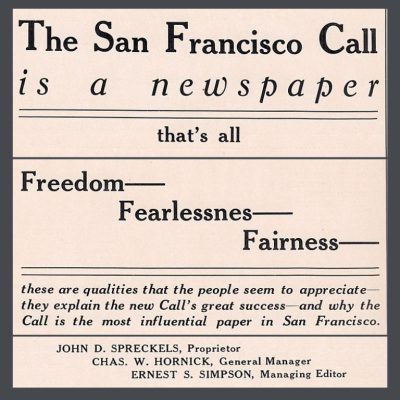 A year later, she was featured in the San Francisco Call who dubbed her an “Ingenious Girl Worker in Metals.”
A year later, she was featured in the San Francisco Call who dubbed her an “Ingenious Girl Worker in Metals.”
The next year, 1908, Palmer traveled to Europe & Asia to learn more about the Arts & Crafts aesthetic. She took courses in metal crafting & electrical design in Vienna & later, back in the United States, she studied power-efficient lighting & the new science of lighting placement to reduce eye strain. In 1910, she opened the “Palmer Copper Shop” in San Francisco. She expressed her work as, “designing fixtures that not only attain the desired lighting effects in a given room, but also conform to the style & contour of the room & the usage to which it is to be put,” clearly utilizing the new knowledge & skills that she had absorbed in Europe.
When metal became scarce with the beginning of World War I, she again drew on her experience & education, becoming active in many California women’s clubs, speaking on topics such as “Electric Lighting of Dwellings from the Standpoint of Health, Economic operation, Science & Ornament,” “Starting in Business with Ninety Cents & No Experience,” “Housewives Learning to Wield, Saw & Hammer,” & “Women as Builders of Business.” She was able to return to metalworking in 1931 to resume her place as one of the iconic women in Arts & Crafts lighting.
Check out my Pinterest page on Lillian Palmer to see more of her stunning work.
ELIZABETH EATON BURTON
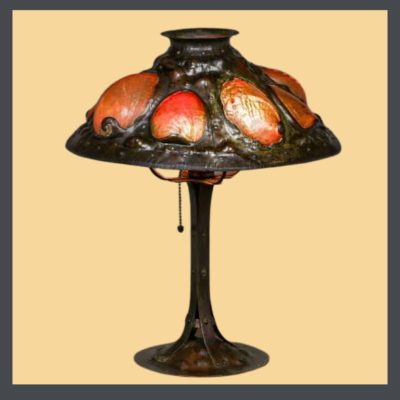 Burton’s prolific work speaks to my heart. I can easily imagine her working in her Santa Barbara studio, gracefully executing her designs, choosing her shells, carefully placing them in the metal & finally inspecting the illuminated lamp, admiring its warm glow.
Burton’s prolific work speaks to my heart. I can easily imagine her working in her Santa Barbara studio, gracefully executing her designs, choosing her shells, carefully placing them in the metal & finally inspecting the illuminated lamp, admiring its warm glow.
There is an ease to her work that I believe came from growing up as the daughter of an artist, Charles Frederik Burton. Like May Morris, her life was filled with the creating of art & beauty from its earliest days. She was clearly influenced by her environment- the sea providing her with both materials & inspiration for her lamps.
She is most well known for her hammered & repousséd copper lamps & sconces in floral motifs set with shells. But, after establishing herself in the Southern California art scene as a woman in Arts & Crafts lighting, through exhibiting in art shows & craft fairs, she also began making unique woodcuts, watercolors, book bindings, tooled leather décor, screens & stained glass. A great deal of her work is unsigned but being unique in design & meticulously crafted, it is not difficult to identify.
My Pinterest page displays many more examples of her work. Please give yourself a treat & visit there!
This article is one in a series about lighting in the Arts & Crafts period. Make sure that you read them all !!
 Part 1, OUT OF THE DARKNESS
Part 1, OUT OF THE DARKNESS
The harnessing of light.
 Part 2, THE CRAFTSMAN MAGAZINE LIGHTING ARTICLE
Part 2, THE CRAFTSMAN MAGAZINE LIGHTING ARTICLE
Tips on utilizing this new technology in the home.
 Part 3, THE LIGHTING OF THE A & C ERA
Part 3, THE LIGHTING OF THE A & C ERA
How lighting expresses the philosophy & aesthetic of the Movement.
 Part 4, ARTS & CRAFTS LIGHTING DESIGNERS
Part 4, ARTS & CRAFTS LIGHTING DESIGNERS
Taking a look at how this new technology provided a market & how the market was served.
 Part 6, ANTIQUE ARTS & CRAFTS LIGHTING RESOURCES
Part 6, ANTIQUE ARTS & CRAFTS LIGHTING RESOURCES
If you want something authentic, but not a museum piece.
 Part 7, MODERN DAY ARTS & CRAFTS LIGHTING MASTERS
Part 7, MODERN DAY ARTS & CRAFTS LIGHTING MASTERS
Craftsmen honoring the tradition.
 Part 8, REPRODUCTION ARTS & CRAFTS RESOURCES
Part 8, REPRODUCTION ARTS & CRAFTS RESOURCES
Another beautiful option.

STAY IN THE BUNGALOW KNOW!!!
Sign up for our newsletter & receive our FREE E-book, 7 VITAL Things to Do Before You Hire a Contractor.
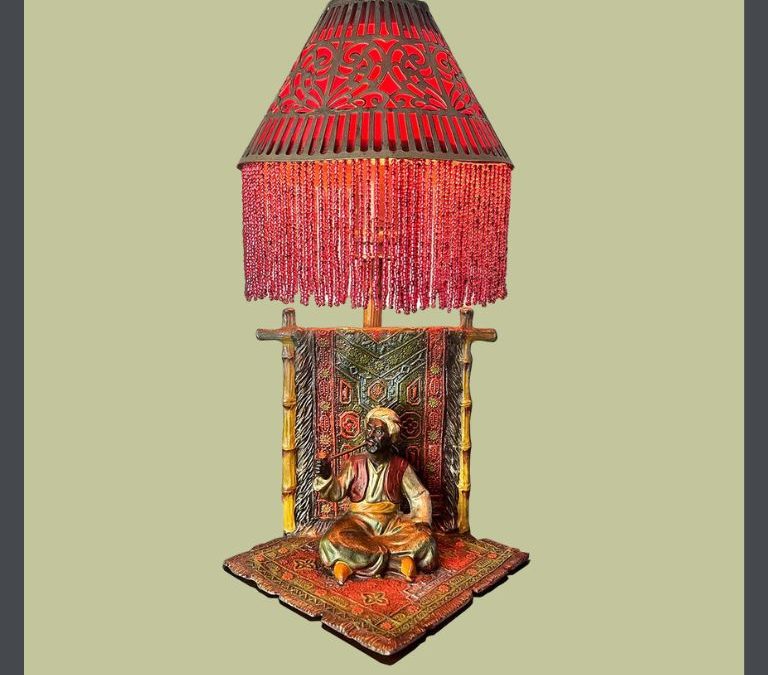
by bungalow101 | Aug 14, 2023 | The arts & the crafts
ANTIQUE ARTS & CRAFTS LIGHTING RESOURCES
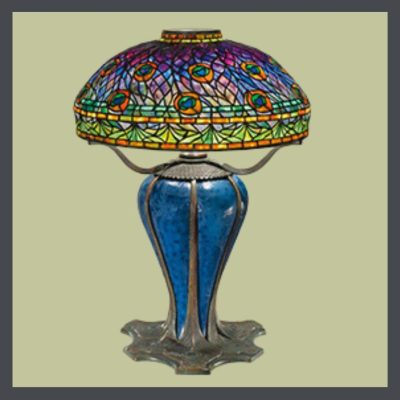 There was a great deal of lighting manufactured 100 years that doesn’t come with a designer name & a designer price tag. (An authentic Tiffany, as an example, can set you back a cool $2,000,000.) For anyone not living in a Greene & Greene or other bungamansion, this lighting is beautiful, highly appropriate & will complement the other features of your home. Some of the shops listed below are online sources & some are brick & mortar, which sell online also.
There was a great deal of lighting manufactured 100 years that doesn’t come with a designer name & a designer price tag. (An authentic Tiffany, as an example, can set you back a cool $2,000,000.) For anyone not living in a Greene & Greene or other bungamansion, this lighting is beautiful, highly appropriate & will complement the other features of your home. Some of the shops listed below are online sources & some are brick & mortar, which sell online also.
Before I begin, let me mention that salvage shops are wonderful sources of old lighting fixtures & may also have some table & floor lamps. They can also be found at antique stores, mostly those specializing in A&C. I have also done well on eBay & Etsy though I have received pieces that were not as represented.
Even if you are not in the market for lighting, please visit & browse these sites, read the stories & admire their merchandise. The proprietors of these businesses have all devoted decades to learning about, collecting, restoring & selling lighting. Just looking at their pages will provide you with a wonderful education on the Arts & Crafts aesthetic.
HERE’S THE LIST OF ANTIQUE ARTS & CRAFTS LIGHTING RESOURCES
GENUINE ANTIQUE LIGHTING
Exclusively Restoring and Selling Antique Lights Since 1979
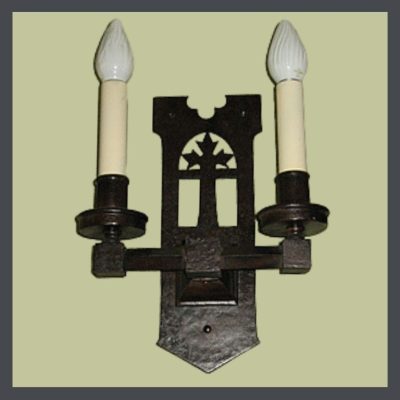 A lovely collection of old fixtures from 1840-1940, that have been painstakingly restored with upgraded hardware & rewired to current code. He can also change a gas fixture into an electric one. In most cases they use antique shades, however, they also stock gas & electric shade reproductions.
A lovely collection of old fixtures from 1840-1940, that have been painstakingly restored with upgraded hardware & rewired to current code. He can also change a gas fixture into an electric one. In most cases they use antique shades, however, they also stock gas & electric shade reproductions.
They buy from other dealers who are not equipped to perform restoration work, nor have the skills. Their work is meticulous, honoring the age of each piece.
Carrying lamps from all periods they have some great A&C fixtures. Their selection of kitchen lighting is extensive, varied & whimsical. I follow them on Facebook & greatly enjoy seeing their changing inventory.
Their website clearly lays out their policies & practices, from shipping to returns. They do have a storefront, open by appointment in Boston.
TURN OF THE CENTURY LIGHTING
North America’s Finest Selection of Antique & Vintage Lighting
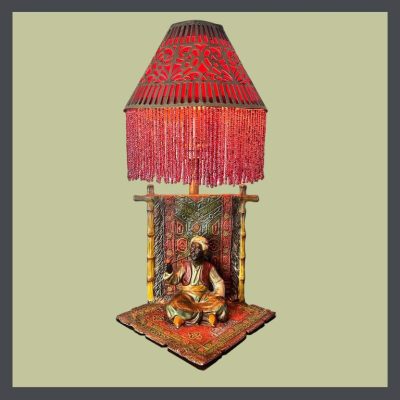 The shop is in Canada (Toronto) & I know that most of you are in the United States. I have no clue as to how the American dollar is currently performing in Canada, nor do I know what shipping would be to your bungalow in Hometown, USA, but you need to at least visit their page & experience this lighting!
The shop is in Canada (Toronto) & I know that most of you are in the United States. I have no clue as to how the American dollar is currently performing in Canada, nor do I know what shipping would be to your bungalow in Hometown, USA, but you need to at least visit their page & experience this lighting!
If you’re venturing up that way, stop in at their glorious showroom & feast thine eyes. A prime example, this lamp is one of the coolest I have ever seen. Made in the early 1900’s in Austrian, these figural lamps were made of bronze or spelter (an alloy in which zinc is the main constituent) & were often painted as the metal was cooling, creating a an enamel like finish. I love the red silk shade with its open work pierced detail & original beaded trim. Rewired & ready to enjoy, I’d use it in my bungalow in a heartbeat!
They also have a collection of new lights that are available in 5 different finishes, some of which would be appropriate in a bungalow. For those of you nearby, they perform complete restorations & rewires as well as & repairing & recovering lampshades. Its goods & services make it truly one of the finest antique Arts & Crafts lighting resources.
Vintage Hardware & Lighting
Producer of Historic Home Hardware and Classic Lighting since 1978.
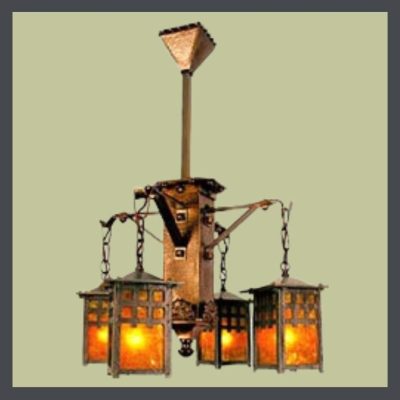 I think that these folks have an incredible selection of all types of lighting- chandeliers, pendants, flush mount, sconces, kitchen & bathroom. They have a small number of table lamps.
I think that these folks have an incredible selection of all types of lighting- chandeliers, pendants, flush mount, sconces, kitchen & bathroom. They have a small number of table lamps.
They also carry parts such as shades, candle covers & other components & perform lighting fixture repair.
Their selection of hardware is extensive- door hardware, reproductions of antique originals, door knockers, thresholds & kickplates, doorbells, locks, mailboxes & mailslots.
Sadly, the brick & mortar facility & museum are closed due to staffing shortages but they are still selling online & will respond to your call or email.
Vintage Lights.com
Only Vintage Fixtures
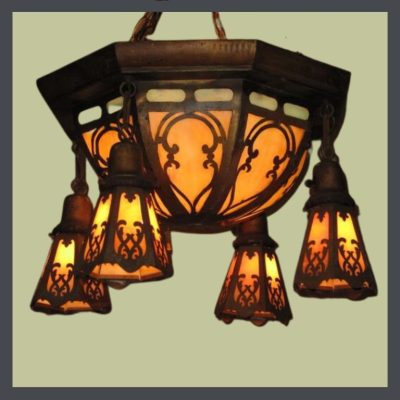 A sweet collection of lighting from 1890-1930, they follow Morris’ dictum, “If you want a golden rule that will fit everybody, this is it: Have nothing in your house that you do not know to be useful, or believe to be beautiful.”
A sweet collection of lighting from 1890-1930, they follow Morris’ dictum, “If you want a golden rule that will fit everybody, this is it: Have nothing in your house that you do not know to be useful, or believe to be beautiful.”
They offer ceiling lamps, wall sconces, porch lighting, slip shades. & some table lamps. Worth noting is that they have some of the most appealing A& C lighting I have ever seen!
They have a far larger inventory than those shown on the website, which is mid-upgrade. If you need a lighting fixture for your bungalow, give their knowledgeable, friendly proprietor Patrick a ring or an email & he’ll show you his abundant wares.
Check out my Pinterest page of their A&C lighting for more items, some available, some sold, restored & some not yet. These lights will provide you with the best education on A&C lighting you could get anywhere!
WHO ARE YOUR FAVORITES, PLEASE?
These are mine, but I am certain that you have discovered many others. I’d like to hear from you & learn whose lighting illuminates your bungalow. Drop me a line!
THIS IS JUST ONE PART OF AN IN-DEPTH SERIES ON LIGHTING
Read them all!
 Part 1, OUT OF THE DARKNESS
Part 1, OUT OF THE DARKNESS
The harnessing of light.
 Part 2, THE CRAFTSMAN MAGAZINE LIGHTING ARTICLE
Part 2, THE CRAFTSMAN MAGAZINE LIGHTING ARTICLE
Tips on using this new technology in the home.
 Part 3, THE LIGHTING OF THE A & C ERA
Part 3, THE LIGHTING OF THE A & C ERA
How lighting expresses the philosophy & aesthetic of the Movement.
 Part 4, ARTS & CRAFTS LIGHTING DESIGNERS
Part 4, ARTS & CRAFTS LIGHTING DESIGNERS
Taking a look at how this new technology provided a market & how the market was served.
 Part 5, WOMEN IN ARTS & CRAFTS LIGHTING
Part 5, WOMEN IN ARTS & CRAFTS LIGHTING
2 women who contributed to the Movement with their beautiful lamps.
 Part 7, MODERN DAY ARTS & CRAFTS LIGHTING MASTERS
Part 7, MODERN DAY ARTS & CRAFTS LIGHTING MASTERS
Craftsmen honoring the tradition.
 Part 8, REPRODUCTION ARTS & CRAFTS RESOURCES
Part 8, REPRODUCTION ARTS & CRAFTS RESOURCES
Another beautiful option.

STAY IN THE BUNGALOW KNOW!!!
Sign up for our newsletter & receive our FREE E-book, 7 VITAL Things to Do Before You Hire a Contractor.

 The desire for lighting is in our DNA. Our circadian rhythms, our bodies’ clocks, determine the patterns of our bodies, our minds & behavior over a 24 hour cycle & respond to light & dark. Light exposure generates signals from our brains, releasing hormones that keep us awake & perky during the day. Darkness activates sleep hormones.
The desire for lighting is in our DNA. Our circadian rhythms, our bodies’ clocks, determine the patterns of our bodies, our minds & behavior over a 24 hour cycle & respond to light & dark. Light exposure generates signals from our brains, releasing hormones that keep us awake & perky during the day. Darkness activates sleep hormones. The kerosene lamp was developed in 1850 & was used until electricity took its place. This type of lamp is still sometimes used in emergencies when electricity fails & light is needed.
The kerosene lamp was developed in 1850 & was used until electricity took its place. This type of lamp is still sometimes used in emergencies when electricity fails & light is needed. There’s nothing more beautiful than the fixtures you see in the Gamble House, or the amazing lamps of Stickley & other masters you see in the Museum of the American Arts and Crafts Movement in St. Pete, Florida.
There’s nothing more beautiful than the fixtures you see in the Gamble House, or the amazing lamps of Stickley & other masters you see in the Museum of the American Arts and Crafts Movement in St. Pete, Florida. This is not meant in any way to denigrate your home. It is merely to state that the look & feel of your house are different from these bunga-mansions (as Jane Powell termed her magnificent house in Oakland) as their decorative elements look no more appropriate in a more simple home than would the crown jewels with your jeans. (And yes, I know that there are those out there who would wear such a combination & 1 in 1,000 of them would pull it off.) There are still some amazing options out there that would enhance your home rather than overwhelming it.
This is not meant in any way to denigrate your home. It is merely to state that the look & feel of your house are different from these bunga-mansions (as Jane Powell termed her magnificent house in Oakland) as their decorative elements look no more appropriate in a more simple home than would the crown jewels with your jeans. (And yes, I know that there are those out there who would wear such a combination & 1 in 1,000 of them would pull it off.) There are still some amazing options out there that would enhance your home rather than overwhelming it.
![]() Part 2, THE CRAFTSMAN MAGAZINE LIGHTING ARTICLE
Part 2, THE CRAFTSMAN MAGAZINE LIGHTING ARTICLE![]() Part 3, THE LIGHTING OF THE A & C ERA
Part 3, THE LIGHTING OF THE A & C ERA![]() Part 4, ARTS & CRAFTS LIGHTING DESIGNERS
Part 4, ARTS & CRAFTS LIGHTING DESIGNERS![]() Part 5, WOMEN IN ARTS & CRAFTS LIGHTING
Part 5, WOMEN IN ARTS & CRAFTS LIGHTING![]() Part 6, ANTIQUE ARTS & CRAFTS LIGHTING RESOURCES
Part 6, ANTIQUE ARTS & CRAFTS LIGHTING RESOURCES![]() Part 7, MODERN DAY ARTS & CRAFTS LIGHTING MASTERS
Part 7, MODERN DAY ARTS & CRAFTS LIGHTING MASTERS![]() Part 8, REPRODUCTION ARTS & CRAFTS RESOURCES
Part 8, REPRODUCTION ARTS & CRAFTS RESOURCES



 We move into a new house, even an old house that’s new to us, & the electrical is just there, be it knob & tube, or an updated system. It wasn’t always this way!
We move into a new house, even an old house that’s new to us, & the electrical is just there, be it knob & tube, or an updated system. It wasn’t always this way! 









 The lighting of the A&C era parallels the philosophy & aesthetic of period. Pieces were uncomplicated, inspired by nature & complemented the look of the architecture, the furniture & the other items in the room. Materials were employed “honestly,” which is to say, they were not meant to have the appearance of something that they were simply not. Metal was not molded & gilded to resemble a bouquet of flowers. It was hammered & patinated to enhance its natural qualities. Lamps were made of clay from the earth, or even willow branches. Those created by Californian
The lighting of the A&C era parallels the philosophy & aesthetic of period. Pieces were uncomplicated, inspired by nature & complemented the look of the architecture, the furniture & the other items in the room. Materials were employed “honestly,” which is to say, they were not meant to have the appearance of something that they were simply not. Metal was not molded & gilded to resemble a bouquet of flowers. It was hammered & patinated to enhance its natural qualities. Lamps were made of clay from the earth, or even willow branches. Those created by Californian  Like our homes with their myriad influences, both high style & vernacular, from the rustic hut of India to the Swiss Chalet to the flair of Japan, the lighting of the A&C era displays a charming range of styles, many of which are appropriate in our bungalows. Some styles are easy to combine, & others are not so easy to integrate. For example, a more modest
Like our homes with their myriad influences, both high style & vernacular, from the rustic hut of India to the Swiss Chalet to the flair of Japan, the lighting of the A&C era displays a charming range of styles, many of which are appropriate in our bungalows. Some styles are easy to combine, & others are not so easy to integrate. For example, a more modest  Jane Powell’s book,
Jane Powell’s book, 
 In 1882, the first houses in America got electricity by direct current after Thomas A Edison opened the Pearl Street Power Station in New York City. Consuming coal for fuel, Pearl Street Station, began by serving 400 lamps at 82 houses. Only 2 years later, Pearl Street Station was serving 508 customers with 10,164 lamps! A wonderful opportunity for the Arts & Crafts lighting designers of the period.
In 1882, the first houses in America got electricity by direct current after Thomas A Edison opened the Pearl Street Power Station in New York City. Consuming coal for fuel, Pearl Street Station, began by serving 400 lamps at 82 houses. Only 2 years later, Pearl Street Station was serving 508 customers with 10,164 lamps! A wonderful opportunity for the Arts & Crafts lighting designers of the period. I consider Van Erp’s simple lighting, constructed of hand-hammered copper with mica shades, to be iconic symbols of the Arts & Crafts Movement. He is considered to be the most important metalsmith of the Movement & one of the foremost Arts & Crafts lighting designers.
I consider Van Erp’s simple lighting, constructed of hand-hammered copper with mica shades, to be iconic symbols of the Arts & Crafts Movement. He is considered to be the most important metalsmith of the Movement & one of the foremost Arts & Crafts lighting designers. In addition to his rustic hammering, Van Erp was admired for the beautiful patinas of his pieces. These were created by the use of assorted chemicals & processes depending on the color desired- primarily red, but yellow & dark browns often added interest & depth to the red. Van Erp did not teach the methods or the formulations of these applied patinas to his apprentices, nor even to own his children! Over the decades, people have experimented with many materials- chalk, brick dust, various chemicals trying to duplicate his colors. No one has achieved a dependable formula.
In addition to his rustic hammering, Van Erp was admired for the beautiful patinas of his pieces. These were created by the use of assorted chemicals & processes depending on the color desired- primarily red, but yellow & dark browns often added interest & depth to the red. Van Erp did not teach the methods or the formulations of these applied patinas to his apprentices, nor even to own his children! Over the decades, people have experimented with many materials- chalk, brick dust, various chemicals trying to duplicate his colors. No one has achieved a dependable formula. “Since evening is often the time when each member of the family is most at liberty to enjoy the home, it appears as a matter of reason that it should, wherever possible, be well and artistically lighted. In fact light stands for cheerfulness as well as brilliancy, for decoration as well as utility, for cosiness as well as sharp disclosures. Whatever else may be the qualities of the home furnishings, yet are they dependent upon whether a cursory or a careful study has been given to their illumination.”
“Since evening is often the time when each member of the family is most at liberty to enjoy the home, it appears as a matter of reason that it should, wherever possible, be well and artistically lighted. In fact light stands for cheerfulness as well as brilliancy, for decoration as well as utility, for cosiness as well as sharp disclosures. Whatever else may be the qualities of the home furnishings, yet are they dependent upon whether a cursory or a careful study has been given to their illumination.” An entrepreneur is defined as a person who organizes and operates a business or businesses, taking on greater than normal financial risks in order to do so. Stickley definitely took enormous risks as he strove to be the arbiter of taste for his period. Like Martha Stewart, in his publication, The Craftsman Magazine, there are articles about landscaping, furnishings architecture, good design, even encouraging home crafting by printing plans for making furniture in the Craftsman style. He built a bit of an empire- a large department store in which he sold furniture, lighting, textiles, in the style he termed Craftsman. His home, in which he had planned to start a school, became a farm where he grew the food for the beautiful restaurant in his store. A good way to understand him & his contributions is to watch these
An entrepreneur is defined as a person who organizes and operates a business or businesses, taking on greater than normal financial risks in order to do so. Stickley definitely took enormous risks as he strove to be the arbiter of taste for his period. Like Martha Stewart, in his publication, The Craftsman Magazine, there are articles about landscaping, furnishings architecture, good design, even encouraging home crafting by printing plans for making furniture in the Craftsman style. He built a bit of an empire- a large department store in which he sold furniture, lighting, textiles, in the style he termed Craftsman. His home, in which he had planned to start a school, became a farm where he grew the food for the beautiful restaurant in his store. A good way to understand him & his contributions is to watch these 

 There were many women who were involved in the making of Arts & Crafts lighting. For example, at Grueby, a pottery manufacturer which often partnered with other designers such as Stickley & Tiffany to make lamps, male potters formed the clay & women painted it. Newcomb Pottery, which also made lamps, was founded in 1895 as an educational experiment of H. Sophie Newcomb Memorial College (Tulane University’s former women’s college) in New Orleans. The quasi-commercial program provided an opportunity for Southern women to support themselves financially during & after their training as artisans.
There were many women who were involved in the making of Arts & Crafts lighting. For example, at Grueby, a pottery manufacturer which often partnered with other designers such as Stickley & Tiffany to make lamps, male potters formed the clay & women painted it. Newcomb Pottery, which also made lamps, was founded in 1895 as an educational experiment of H. Sophie Newcomb Memorial College (Tulane University’s former women’s college) in New Orleans. The quasi-commercial program provided an opportunity for Southern women to support themselves financially during & after their training as artisans. Palmer &
Palmer &  A year later, she was featured in the San Francisco Call who dubbed her an “Ingenious Girl Worker in Metals.”
A year later, she was featured in the San Francisco Call who dubbed her an “Ingenious Girl Worker in Metals.” Burton’s prolific work speaks to my heart. I can easily imagine her working in her Santa Barbara studio, gracefully executing her designs, choosing her shells, carefully placing them in the metal & finally inspecting the illuminated lamp, admiring its warm glow.
Burton’s prolific work speaks to my heart. I can easily imagine her working in her Santa Barbara studio, gracefully executing her designs, choosing her shells, carefully placing them in the metal & finally inspecting the illuminated lamp, admiring its warm glow.
 There was a great deal of lighting manufactured 100 years that doesn’t come with a designer name & a designer price tag. (An authentic Tiffany, as an example, can set you back a cool $2,000,000.) For anyone not living in a Greene & Greene or other bungamansion, this lighting is beautiful, highly appropriate & will complement the other features of your home. Some of the shops listed below are online sources & some are brick & mortar, which sell online also.
There was a great deal of lighting manufactured 100 years that doesn’t come with a designer name & a designer price tag. (An authentic Tiffany, as an example, can set you back a cool $2,000,000.) For anyone not living in a Greene & Greene or other bungamansion, this lighting is beautiful, highly appropriate & will complement the other features of your home. Some of the shops listed below are online sources & some are brick & mortar, which sell online also. A lovely collection of old fixtures from 1840-1940, that have been painstakingly restored with upgraded hardware & rewired to current code. He can also change a gas fixture into an electric one. In most cases they use antique shades, however, they also stock gas & electric shade reproductions.
A lovely collection of old fixtures from 1840-1940, that have been painstakingly restored with upgraded hardware & rewired to current code. He can also change a gas fixture into an electric one. In most cases they use antique shades, however, they also stock gas & electric shade reproductions. The shop is in Canada (Toronto) & I know that most of you are in the United States. I have no clue as to how the American dollar is currently performing in Canada, nor do I know what shipping would be to your bungalow in Hometown, USA, but you need to at least visit their page & experience this lighting!
The shop is in Canada (Toronto) & I know that most of you are in the United States. I have no clue as to how the American dollar is currently performing in Canada, nor do I know what shipping would be to your bungalow in Hometown, USA, but you need to at least visit their page & experience this lighting! I think that these folks have an incredible selection of all types of lighting- chandeliers, pendants, flush mount, sconces, kitchen & bathroom. They have a small number of table lamps.
I think that these folks have an incredible selection of all types of lighting- chandeliers, pendants, flush mount, sconces, kitchen & bathroom. They have a small number of table lamps. A sweet collection of lighting from 1890-1930, they follow Morris’ dictum, “If you want a golden rule that will fit everybody, this is it: Have nothing in your house that you do not know to be useful, or believe to be beautiful.”
A sweet collection of lighting from 1890-1930, they follow Morris’ dictum, “If you want a golden rule that will fit everybody, this is it: Have nothing in your house that you do not know to be useful, or believe to be beautiful.”